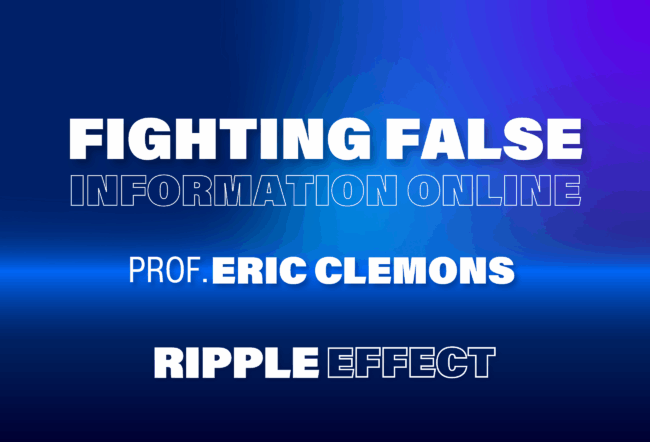Anyone who has watched the evolution of technology knows that sometimes, clever new technologies emerge and quickly supplant the incumbents, while others may take years or decades to take off — if they gain widespread traction at all. So for investors, consumers and businesses, the key question is: What is the differentiating factor between the fast winners and the slow losers?
In their paper, “Innovation Ecosystems and the Pace of Substitution: Re-examining Technology S-curves,” published in the Strategic Management Journal, Wharton management professor Rahul Kapoor and Ron Adner, a professor at the Tuck School of Business at Dartmouth College, attempted to answer this question by examining not just competing technologies, but also the ecosystems in which they were embedded. And they have come up with a solid hypothesis. Kapoor recently talked to Knowledge at Wharton about the implications of their findings for businesses, governments and consumers — both early adopters and the patient mainstream.
Edited excerpts from the conversation appear below.
A Question of Adoption
This research is really looking at a puzzle that we observed, in terms of new technologies being introduced into the market: There are significant differences in terms of how fast they are able to reach mainstream adoption and disrupt existing markets and players. For example, we observed that in the printer space, inkjet printers came about quickly, and rapidly overtook the dot matrix. Then look at HDTV: It took decades for it to achieve mainstream adoption. And then, you can look at things like the Segway, or the Palm types of technologies, which either created some value, or never really reached mainstream adoption.
So the question was really, what explains why some technologies are introduced and immediately supplant the existing technologies, whereas others take decades, or sometimes don’t reach mainstream adoption at all? We tried to find a context where we could observe enough variation in terms of how quick or slow these technology adoption patterns were — but one that helped us to control for a lot of confounding effects, as well. The idea was to find a natural experiment, so to speak. And that helps us to ensure that the source of adoption is not driven by some systematic effects, which we could not observe, and which may make inferences more problematic.
“When you think about the batteries used in electric cars, you must also think about charging stations, and the garages that can fix those electric cars.”
I had some experience in the semiconductor industry, and we came across semiconductor lithography as a technology that would allow us to study this question. What is interesting about the setting is that it’s the engine behind Moore’s Law. Any progress in semiconductors over the last 40 years has been fueled by lithography technology, so it’s important. We know it’s fast-paced, and we thought that it was where we might want to study this question.
We studied 10 different technologies that were introduced in the semiconductor lithography industry over a 40-year period. We interviewed about 30 industry experts to try to get a sense for what drove the different patterns of market adoption. We collected data on technologies, markets, firm, in an effort to really try to understand the factors that might explain these differences. What we found was interesting. You know, a lot of the research and practice focuses on new technologies, and how they interact with the markets. It looks at the question, is the technology better than what’s available now, or not? And that is viewed as explaining whether it’s going to reach mainstream adoption.
We found that is part of the explanation — actually, in our case, a very small part of the explanation. We found that the bigger explanation was not to be found in the new technology, and the market, but within the technology ecosystem: How is the technology created? What are the different elements that make up the technologies?
Another question is, how is the technology used, in terms of other elements or complementary technologies and services? So when you think about the batteries used in electric cars, you must also think about charging stations, and the garages that can fix those electric cars.
And not only that: You need to look at the technology ecosystems for both the new technology and the old technology. What we set out as our goal was, we wanted to explain this variance. What we saw from our field work and heard in our interviews, that by looking at the technology itself, the resolution in terms of whether adoption is going to be fast versus slow is not going to be very clear. So instead, we said, let’s look at the ecosystem. We collected data that systematically described each technology in terms of its ecosystem, and compared it to the pre-existing technology.
When it comes to new technology, there is sometimes what we call an ecosystem emergence challenge: The technology is ready, but the ecosystem still needs some investments, like the charging infrastructure for electric cars, for it to reach mainstream adoption.
But with the old technologies, we also saw that sometimes, you can extend their lifespans by making improvements in components, or in complementary elements. Think about gasoline cars, for example: Nobody thought, 10 or 15 years ago, that they would be getting 30 miles per gallon or even 40 miles per gallon today. But improvements in engines, improvements in fuels, allowed them to get to that point.
Think about the hybrid versus electric car discussion: The hybrid cars introduced were able to grow market share much faster than electric cars. And the main difference was, the hybrid cars could plug and play. There wasn’t an emergence challenge in the ecosystem. Electric cars had these emergence challenges around creating the infrastructure, because they didn’t have the charging stations in place.
After doing this research, we were able to document fairly clearly that if one wanted to understand the likelihood that a new technology was going to come in and immediately disrupt the marketplace, versus taking much longer or that disruption maybe never happening at all, you had to look at the new technology’s ecosystem in terms of emergence challenges, and the old technology’s ecosystem in terms of its extension opportunities. It’s really the joint consideration of these two factors that explains whether you will see a technology make a fast takeoff, or a technology that will never reach mainstream adoption.
Key Takeaways
I think the research presents some very interesting takeaways for managers, for policymakers, for investors in technology companies, and also for users of technologies, whether they are consumers or businesses. If you are a manager of a firm, whether it’s a new start-up or it’s an established firm, you always have to think about the resources that you’ll have to allocate towards new technologies, and how you transition from an existing to a new technology.
Think about how Kodak shifted from chemical-based photography to the digital photography arena. Think about Netflix moving from a DVD rental business to the online streaming business. Managers can use this framework to set realistic expectations in terms of both whether and when to invest in new technologies. Sometimes, not jumping to the new technology actually makes sense. They will generate more shareholder value, or destroy less shareholder value, by focusing on the existing technologies, rather than going all out and pushing for the new technology.
From an investor’s perspective again, it sets realistic expectations when you are investing in technology companies, in their ability to create value over time. Sometimes the expectations could be two years. But as we know, it often takes much longer than that for new technologies to create value.
“To understand the likelihood that a new technology was going to come in and immediately disrupt the marketplace … you had to look at the new technology’s ecosystem in terms of emergence challenges.”
As a user, you have to make the same sort of decisions, whether you’re a business or a consumer. You’re always up against the decision: Should we go for the latest and greatest, or should we wait until the new technology has developed to a point where it creates value? Having the sensibility in terms of understanding the existing ecosystem and new ecosystem can help them make more optimal decisions.
For policymakers, this is a big question in terms of the role of policy in shaping technological progress. We know that a lot of economic progress is driven by improvements in technology. So if you run into a scenario where new technologies are not emerging at the rate where you expect them to emerge, that has a downside in terms of jobs, in terms of economic output, in terms of GDP growth.
So thinking more in terms of ecosystems, both for new technologies and existing technologies, helps all of these actors get better returns on their investments, and get fewer surprises in terms of expectations.
Building a Better Forecast
It was our intention to refine our ability to forecast how technologies are going to evolve over time. The title of the paper mentions S-curves, because those are a way people have thought about it.
There are two different ways people thought about forecasting technological changes. One is thinking about the performance improvements of the technologies, and we know that those performance trajectories tend to take an S-shape. Early stage, you invest a lot, but you’re not getting improvements. Then there’s a takeoff where you expect most of the market takeoff. And then there’s maturity.
Similarly, there is an adoption S-curve, which is that during the early state of a technology, the users who are going to be going after it are not the ones who really care about the total value — they just like the new technology. That’s a very small part of the market. The mainstream users are looking to see, what’s the main value proposition? Not just technology being new. And that depicts an S-shape distribution as well.
So what we were up against is these existing frameworks and tools, which have these nonlinear, S-shaped dynamics. What we are able to show through this ecosystem-based lens is that the pattern of these evolutions, both in terms of technology improvement and market adoption, may not fit well with a smooth S-shaped trajectory. There often could be discontinuous patterns. Having this sensibility can help you predict whether the S-shapes are going to be smooth and evolve quickly, or whether the curves may not be S-shaped, and may actually get resolved in a much longer time frame.
Where I’m going with this project is to have a model and an approach that helps us to improve technology forecasting. In fact, one of the things I was surprised by when we were doing this research was the amount of resources that both companies and governments were expending into these new technologies — often running into hundreds of millions of dollars. As you know, the semiconductor industry is very capital-intensive.
And despite these resources and expectations, they had well-documented industry roadmaps that said these new technologies were going to be hitting the mainstream in three to five years. More often than not, they would take twice that amount of time, and in many cases, never take off at all. That’s something that I was not expecting as much. I was expecting some of it, but not at the scale that I observed.
The other issue that I thought was pretty surprising is, we kind of write off existing technologies and old technologies. The cell phone? Nobody’s going to use it. Everybody’s going to shift to tablets and newer ways to do things. But seemingly geriatric technologies continue to create a lot of value for a very long time, which was a counterintuitive finding considering what we expected to see in this research.
Advice for Business
I think from a firm perspective, the big implication is thinking about resource allocation, and whether it makes sense for firms to go all out on these new technologies at the rate that they expect to invest. The other implication from a firm perspective is timing. You know, in a related study, I was able to document that the “first mover advantage,” which we often claim exists in many technology settings, turns out not to [exist]. In fact, we were able to show a significant first mover disadvantage in technologies where the ecosystem emergence challenge was so high, the first movers couldn’t create any value. So issues of timing were important.
“Sometimes, not jumping to the new technology actually makes sense.”
Another issue that I think managers and investors need to think about: A technology is seldom a single artifact, or a single technological element. It is an ecosystem. That makes it very difficult for a firm to control all the elements that go into creating value from their technology.
So one sensibility that I’d like to share with the managers and investors is this. As we think about evaluating technological opportunities, it’s not enough to look at just the focal technology — whether it’s the phone, or it’s the computer, or it’s the car. You have to think about the ecosystem. What are the elements that go into it? And could you orchestrate the ecosystem in a way that mitigates these potential downsides of users not deriving value when the technology is ready?
You know, what was particularly interesting from our study was, every time a new technology was introduced, the technology was actually superior in terms of performance. But despite that, it never reached mainstream adoption. And the explanation for why was really rooted in the ecosystem of the new technology versus the ecosystem of the old technology.
Why the ‘Better Mousetrap’ Doesn’t Always Win
We had a case where a new technology came in with three times, four times better performance. But a critical element that the users needed to use it wasn’t there. So consider it like this: Think of this superior technology as a camera. You need the film. But the film that is available is not good enough for you to get the full potential of this new camera. So users don’t really see an incentive. You’re coming up with the best camera, but with the below-par film available, the total value proposition is not there.
In other cases, the technological advances are fairly incremental, but users are able to plug and play. Like a hybrid car, for example. That doesn’t see this sort of resistance and friction in the marketplace.
From a venture capital perspective, as we think about these entrepreneurial ecosystems as a way for venture capitalists to get in and create value — you cannot just localize on a single firm as a basis of investment and value creation. If you think about e-books as a case in point, a lot of companies like E Ink, back in the day, were funded through a lot of VC money. Both private venture capital and also corporate venture capital.
But it wasn’t about the electronic ink. It was about content. It was about the reader. It was about Amazon’s business model, which had to bring the solution together. So as we think about the opportunities for venture capital for any given technology, it’s not enough to just focus on new technology. We should be thinking about the broader ecosystem, and how one could control and drive progress through the ecosystem.
Buying into the Hype
You see quite often overly optimistic, aggressive expectations about new technologies. Some people refer to it as the ‘hype cycle.’ I think we are able to identify the reasons for those hypes. And just calling something a hype is not enough, in my view. It’s understanding the factors that drive the hype, and then using that as a basis for making good decisions.
There were clearly very high expectations in our research context that these technologies would reach mainstream adoption. We were going to be investing millions if not billions of dollars into these technologies. But it turned out those investments were in vain, because either the ecosystem didn’t emerge at the right time, or at a cost that made it attractive to the users.
The second misperception is that people have these very dramatic views about the decline of the old technologies, and their framing of the world as a world of disruption — the idea that all the value is going to be created through creative destruction coming from new technologies. We do feel that that part of the world is a bit oversold. In fact, a lot of the value in semiconductors — and in many of the other industries that I’ve studied — is being created through continuous innovations and finding market opportunities for existing technologies. We’ve found that in our context as well. There’s a very interesting company called Ultratech that has been in the semiconductor industry for 40 years. It has never been at the cutting edge of the technology, like some of its peers that entered and exited in a fairly short span. But this company has existed for a very long time, and is still creating a lot of shareholder value.
“You see quite often overly optimistic, aggressive expectations about new technologies. Some people refer to it as the ‘hype cycle.’”
So I think those perceptions, in terms of an overly optimistic view of the new technologies, and a very pessimistic view about the value proposition in old technologies, are something that we think needs to be more balanced, as opposed to these extreme views.
Breaking New Ground
We are certainly not the first ones to study new technologies and their ability to create value in the marketplace. But I do think that we are one of the first, if not the first, to bring attention to the important role of the ecosystem in the way technology gets developed and commercialized, and to really understand how these technologies transition. We think it’s not enough to just take the ecosystem perspective – you must also look at both the new technology ecosystem and the old technology ecosystem. It’s really bringing these two ecosystems together as an analytical framework that can generate a lot more valuable insights, in our view.
The other aspect of the research that I’m particularly proud of is the approach that we took to study this question. It required almost two years of field work. We interviewed more than 30 industry practitioners — managers, consultants from a variety of roles in the ecosystem. And that took a lot of time. But we felt that we were able to generate a set of robust findings that made that effort worthwhile. That’s something that we don’t often see in a lot of management research.
What’s Next
This was, in my view, probably a first step for me to try to think about how one could make better decisions in terms of new technologies, and provide a framework that could guide that decision-making. We’re still not quite at the point I would like us to be, in terms of our ability to forecast technologies — both existing and new — and to take a more probabilistic view that can guide managerial decision-making, venture capital investments, and even help policymakers think about.
What I’m moving on is to take the issue of technology forecasting more seriously. Anecdotal evidence suggests that we’re actually very poor technology forecasters. I mean, there’s not a lot of documentation in terms of accuracy of forecasting. But if you look at some of the big technology forecasts that come out, nobody tracks them — which is a problem, of course. But anecdotally, you can tell that a vast majority of them turn out to be wrong, in terms of missing the timing completely, or missing the new technologies that nobody predicted three to five years ago.
So my goal is to think about the theoretical logic, but also think about an approach that helps us to predict new technologies in a way that we have not been able to do so far. I’m starting with the auto sector, which is going through some fairly interesting shifts at the moment. It has been shifting towards electrification, and now we’re talking about autonomous cars. We have the technology companies coming into it, in addition to the auto sector. It’s an environment that presents a lot of uncertainty, but also a lot of variability in terms of technological choices being pursued.
So I’m working on a project where we will try to create good forecasting models, and hopefully we can show their accuracy in predicting the course of many of the technologies being pursued in the auto sector. The hope is that we’ll be able to take that as a template, and apply it in other technology settings. You know, think about the Internet of Things, think about wearable technologies. Think about financial technologies. We could scale this model to make better technology forecasts in all of them.



